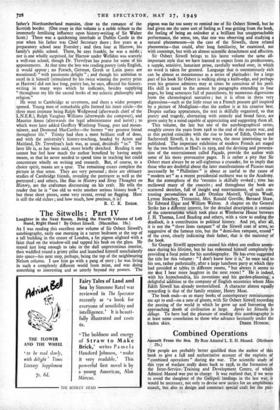The Sitwells : Part IV
Laughter in the Next Room. Being the Fourth Volume of Left Hand, Right Hand ! By Osbert Sitwell. (Macmillan. 18s.) As I was reading this excellent new volume of Sir Osbert Sitwell's autobiography, early one morning in a turret bedroom at the top of a tall building in the centre of London, a fat pigeon alighted with a faint thud on the window-sill and tapped his beak on the glass. He stayed just long enough to take in the dull unpretentious interior, then waddled round a grimy pillar and launched himself nonchalantly into space—his next stop, perhaps, being the top of the neighbouring Nelson column. I saw him go with a pang of envy ; he was living in such a completely different world from mine, and was doing something so interesting and so utterly beyond my powers. The pigeon was far too sooty to remind me of Sir Osbert Sitwell, but he had given me the same sort of feeling as I was getting from the book, the feeling of being an onlooker at a brilliant but unapproachable performance, the sense, too, that one was observing and studying a natural phenomenon—in the case of the Sitwells, three related phenomena—that could, after long familiarity, be examined, not with contempt, but with an almost scientific detachment and affection.
Sir Osbert Sitwell brings to his latest volume the same all- important style that we have learned to expect from its predecessors, a supple, sensitive, luxuriant prose, carefully worked over, in which no word is taken for granted. Language that is ostentatiously rich can be almost as monotonous as a series of platitudes: for a large part of his book Sir Osbert is walking along a knife-edge, and perhaps even his greatest admirers may at times be conscious of his peril. His skill is taxed to the utmost by paragraphs extending to four pages, by long sentences full of parentheses, by numerous digressions from the chronological narrative ; but it is often in these very digressions—such as the little essay on a French peasant girl inspired by a picture of Modigliani—that the author is at his creative best. Despite surface appearances, the text is skilfully organised, so that poetry and tragedy, alternating with comedy and broad farce, are given unity by a mind capable of appreciating and suggesting them all.
This volume, the last but one of the autobiographical series, roughly covers the years from 1918 to the end of the recent war, and as this period coincides with the rise to fame of Edith, Osbert and Sacheverell Sitwell, it is, in some ways, the most interesting so far published. The important exhibition of modern French art staged by the two brothers at Heal's in 1919, and the devising and presenta- tion of the entertainment called Facade, provide the author with some of his more provocative pages. It is rather a pity that Sir Osbert must always be so self-righteous a crusader, for to imply that those who are doubtful about the later manifestations of Picasso must necessarily be " Philistines " is about as useful to the cause of " modern art " as a recent presidential outburst was to the Academy. But the atmosphere of the 'twenties is skilfully evoked ; time has mellowed many of the conceits ; and throughout the book are scattered sketches, full of insight and entertainment, of such con- trasting personalities as Lady Ottoline Morrell, Virginia Woolf, Lytton Strachey, Tetrazzini, Mrs. Ronald Greville, Bernard Shaw, Sir Edward Elgar and William Walton. A chapter on the General Strike has a different interest, for the detailed description it contains of the conversations which took place at Wimborne House between J. H. Thomas, Lord Reading and others, with a view to ending the deadlock, is a contribution to political history; And yet, after all, it is not the " three lions rampant " of the Sitwell coat of arms, so suggestive of the famous trio, but the "demi-lion rampant, erased" of the crest, clearly indicating their father, that is the mainstay of the book.
Sir George Sitwell apparently caused his eldest son endless annoy- ance during his lifetime, but he has redeemed himself completely by providing a focal point for his autobiography. He has even suggested the title for this volume : " I don't know how it is," he once said to his son, rather pathetically, after a large luncheon party at which they had presided at tables in different rooms, " but always it seems to me that I hear more laughter in the next room! " He is indeed, with his hypochondria, his inventions and his garden-planning, a delightful addition to the company of English eccentrics whom Miss Edith Sitwell has already memorialised. A character almost equably rewarding is that of thd family retainer, Henry Moat.
The book ends—as so many books of contemporary reminiscences are apt to end—on a note of gloom, with Sir Osbert Sitwell recording the passing of the world in which he grew up and foreseeing the approaching doom of civilisation at large. Apres les Sitwells le deluge. To have had the pleasure of reading this autobiography is at least some consolation to those who advance hesitantly under the






































 Previous page
Previous page